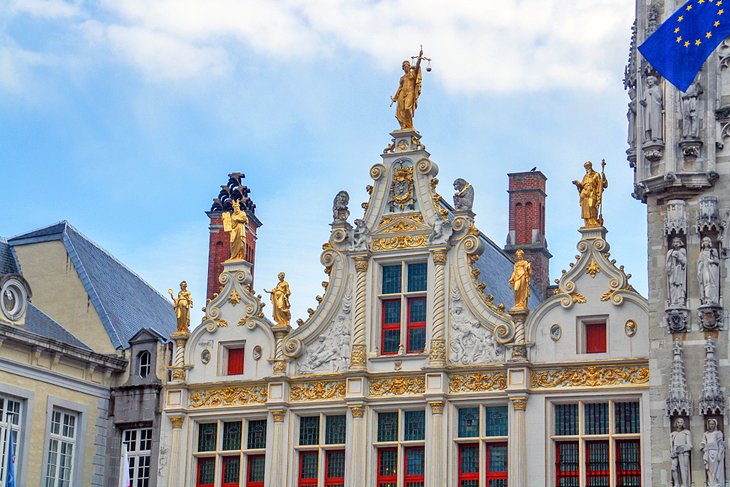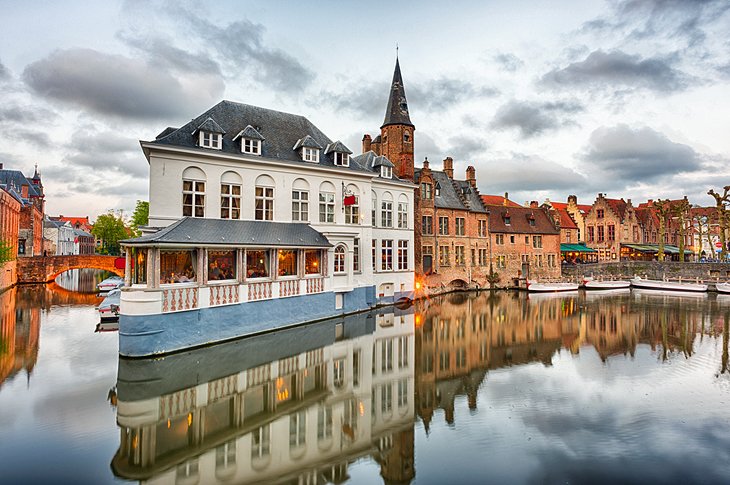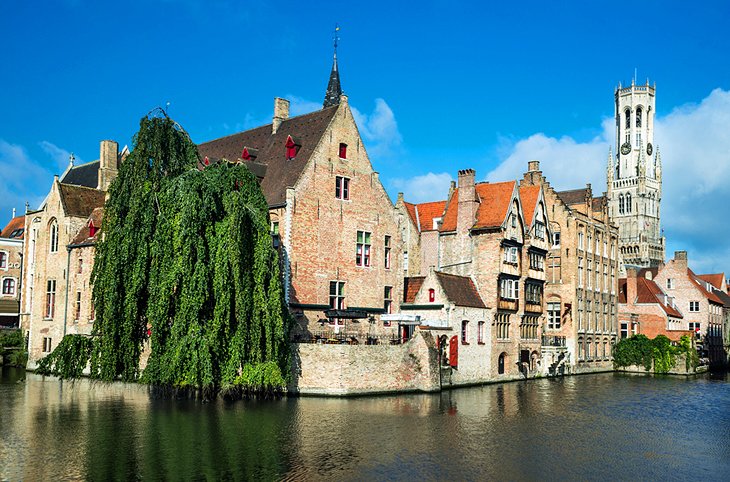Bruges, the capital of West Flanders in northwest Belgium, is
distinguished by its canals, cobbled streets and medieval buildings. Its
port, Zeebrugge, is an important center for fishing and European trade.
The city-center Markt features horse-drawn carriage rides and
17th-century houses converted into restaurants and cafes, as well as the
13th-century belfry with its 47-bell carillon and 83m tower with
panoramic views.
Belfry & Halle

The south side of Bruges' Markt (the main square) is dominated
by the Halle with the belfry - Bruges' most distinctive landmark -
soaring above it. The Halle was begun in 1248 and twice enlarged, first
in the 14th century and then again in the 16th century, and once
functioned as the city's main market place. The building encloses a
picturesque courtyard, and the balcony above the entrance was once used
by the city fathers to promulgate their statutes to the populace
assembled beneath.
The 83-meter-high belfry is one of the finest bell towers in Belgium
and is entered from the Halle's inner courtyard. Construction of the
bell tower began in 1282, and the crowning octagonal upper section was
finally completed in 1482. Today, a carillon of 47 bells still hang in
the tower. For the best view over Bruges, you can climb the 366 steps up
to the top of the tower. On the way up, the old Treasure Room where civic documents are kept behind wrought-iron grills can be visited on the second floor.
Address: Markt, central Bruges
Basilica of the Holy Blood

The Basilica of the Holy Blood (Heilig-Bloedbasiliek) presides over the central plaza known as the Burg.
The church is famous for the crystal vial kept inside that is reputed
to contain a drop of Christ's blood brought back from the Holy Land by
Dietrich of Alsace in 1149 on his return from the Second Crusade. Each
year in May, this sacred relic is carried through the streets of Bruges
in the Procession of the Holy Blood. The facade of the basilica
with its three Flamboyant-style arches and gilded statues was erected
between 1529 and 1534. The basilica itself consists of a Romanesque
lower chapel and a late Gothic upper chapel, which houses relics of St.
Basil brought from Palestine by Robert II, Count of Flanders. An elegant
spiral staircase leads to the upper chapel (built in 1480) where every
Friday the vial containing the Holy Blood is brought out and shown to
the faithful.
Address: Burg, central Bruges
Markt

At the very heart of the city is the Markt; Bruges' bustling main
square, surrounded on all sides by fine buildings from a variety of
different periods. The eastern side is dominated by the Neo-Gothic Provinciaal Hof
building which dates from 1887 and is the seat of the West-Vlaanderen
provincial government. On the western side, occupying the left-hand
corner, is the attractive brick 15th Century Huis Bouchoute. On the opposite corner stands the Craenenburg where, in 1488, at the instigation of Ghent,
the burghers of Bruges kept the future Habsburg Emperor Maximilian
imprisoned for 11 weeks. He was freed only after agreeing to respect the
authority of the ruling Regency Council and to order the withdrawal of
all foreign troops. The best way to admire all this architectural finery
is to join the throngs of visitors and locals at one of the Markt's
many cafés and sit for a while soaking up the historic splendour around
you.
Address: Markt, central Bruges
Town Hall

On the southeast side of the Burg is Bruges' Town Hall
(Stadhuis), one of the oldest in Belgium, having been constructed
between 1376 and 1420. The facade of the delicate Gothic building
displays the strong vertical emphasis characteristic of the style, with
soaring pilasters, three of which end in octagonal turrets, separated by
tall Gothic arched windows. Statues of the counts of Flanders from
Baldwin Iron Arm onwards fill the 49 niches. Inside, don't miss the
great Gothic Hall on the first floor with its beautiful timber
vaulting, which dates from 1402, and its murals recording events in the
town's history by A and J de Vriendt (1895-1900).
Address: Burg 12, central Bruges
Liberty of Bruges

On the east side of the Burg, the Bruges Tourist Office occupies part of what was, up until 1984, the Law Courts,
built between 1722 and 1727 on the site of the former Liberty of Bruges
(Paleis van het Brugse Vrije) from where independent magistrates
exercised jurisdiction over the region. Some fragments of the older
building have survived, including the pretty 16th-century facade
overlooking the canal at the rear. One or two of the more historic rooms
inside are now the Brugse Vrije Museum and can be admired by visitors. Of particular interest is the Schepenzaal (lay magistrates' court) where you can see the famous chimneypiece
designed by the painter Lanceloot Blondeel in 1529 and executed in
black marble and oak by Guyot de Beaugrant. This magnificent piece of
Renaissance craftsmanship has an alabaster frieze above depicting the
story of Susanna and the Elders with carved oak figures of the Emperor
Charles V and his parents, Ferdinand and Isabella of Castille, Mary of
Burgundy, and Maximilian.
Address: Burg, central Bruges
Groeninge Museum

Head to the Dijver Canal, to visit the Groeninge Museum
(Stedelijk Museum voor Schone Kunst), which holds Bruges' best
collection of art. In addition to its excellent endowment of Old Flemish
paintings, the museum also incorporates a gallery of modern art and a
superb collection of views of old Bruges. However, the first five rooms
of the museum are the ones most likely to claim your attention as they
contain quite exceptional paintings by Old Flemish masters. In Room 1 hang two major works by Jan van Eyck: Madonna and the donor, Canon van der Paele (1436) and the portrait of Margaret van Eyck, the artist's wife, painted when she was 33 years of age (1439). In Room 3
are panels illustrating the legend of St. Ursula and a portrait of Luis
Gruuthuse, both famous works by unknown Bruges masters, and the Last Judgment by Hieronymus Bosch is among the paintings in Room 5.
Address: Dijver 12, central Bruges
Church of Our Lady

The 112-meter-high spire of the Church of Our Lady (Onze Lieve
Vrouwekerk) is the tallest in Belgium. Work began on the nave and aisles
around 1230, the outermost aisles and chapels being added in the 14th
and 15th centuries. The church holds a wealth of art treasures, among
which is a sublime sculpture by Michelangelo, Virgin and Child
(1503-04). The sculpture stands on the altar of the chapel at the end of
the south aisle. The Calvary on the high altar is by Bernaert van
Orley, the triptych Adoration of the Shepherds is by Pieter Pourbus, and the Transfiguration of Christ is by Gerard David.
Address: Dijver, central Bruges
Memling Museum

In the Memling Museum, six exquisite master-pieces by Hans
Memling (ca. 1430-94) are on view, each a pearl of Old Flemish art.
Outstanding even among these is the Reliquary of St. Ursula (1489), recognized as one of the master's most important works. Scarcely less famous is the Mystic Marriage of St. Catherine,
painted for the so-called St. John altar. Completed in 1479, it depicts
Saints Barbara and Catherine flanked by St. John the Baptist and St.
John the Evangelist. The four other works by Memling in the museum are
the Maarten van Nieuwenhove diptych of 1487 (with the Virgin handing the
Christ child an apple on one wing, and a superb portrait of the donor
on the other ), a triptych (1479) with the Adoration of the Magi and the donor Jan Floreins, another triptych with the Descent from the Cross (1480) and finally, the portrait of Sibylla Zambetha (1480).
Address: Dijver, central Bruges
Sint-Jansspitaal

Immediately opposite the west door of the Church of Our Lady
stands the oldest building in Bruges, the Sint-Jansspitaal founded in
the 12th century. Look up at the tympanum, over the bricked up gate to
the left of the Mariastraat entrance, embellished with reliefs showing
the Virgin, which bears the date 1270. Inside the ancient building, in
what were once wards, an exhibition of documents and surgical
instruments charts the hospital's history. The old dispensary adjacent
to the wards has also been preserved. South of Sint-Jansspitaal is the
street of Walstraat rimmed by tiny, exceptionally pretty, gabled 16th- and 17th-century houses in which lacemakers still practice their craft.
Address: Katelijnestraat, central Bruges
Béguinage

In medieval times, Minnewater (the "Lake of Love"), on the far side of Wijngaardplein, was part of Bruges' busy outer harbour. Nowadays, only the Gothic Lock House
(sluishuis) at the north end provides a clue to its far-from-tranquil
past. Standing by the Lock House is a lovely view of the bridge over to
Bruges' Béguinage (Prinselijk Begijnhof ten Wijngaerde) with its white
17th-century houses grouped around a grassy, tree-shaded court. It was
founded in 1245 by Margaret of Constantinople, and today is the home of
Benedictine nuns. Between the entrance gate and church (founded 1245,
restored 1605), one of the former béguine houses has been turned into
the Begijnhof museum, which offers a fascinating insight into life in the béguinage.
Address: Wijngaardplein, Bruges
Dijver Mansions

On the left, at the far end of the Dijver Canal, stands an attractive ensemble of 15th-century buildings comprising what was once the Heren van Gruuthuse
mansion. Here in 1471, the fugitive English king Edward IV took
shelter. The original "heren" were merchants with a monopoly on the
trade in dried herbs (gruut). Part of the mansion is now home to the
exceptional Gruuthusemuseum, which holds a superb collection of
antiques and applied art occupying 22 rooms. Particularly eye-catching
are the lacework, carvings, tapestries, and weaponry, also the
delightfully restored and completely authentic old Flemish kitchen and
the dispensary. The Brangwyn Museum, in the 18th century
Arentshuis next door to the Gruuthusemuseum, has porcelains, pewter
ware, ceramics, mother-of-pearl ware, and a charming collection of views
of old Bruges as well as an exhibition of paintings and drawings by the
Bruges-born English artist Frank Brangwyn (1867-1956).
Address: Dijver, Bruges
Sint-Salvatorskathedraal

From the Church of Our Lady, take the short street of Heilige
Geeststraat to the Sint- Salvatorskathedraal, the oldest parish church in
Bruges and a cathedral since 1834. Originally founded in the 10th
century, most parts of the present building date from the 12th and 13th
centuries. The fortress-like 99-meter-high west tower was constructed in
several phases, the lower Romanesque portion between 1116 and 1227 and
the brick section between 1183 and 1228. Over the centuries, the
cathedral has survived four fires as well as the iconoclastic fury. The
101-meter-long interior contains some noteworthy furnishings. Especially
outstanding are the Baroque rood-screen with a figure of God the Father by Artus Quellin the Younger, the 15th-century choir stalls
embellished with the coats of arms of Knights of the Golden Fleece and,
above the stalls, Brussels tapestries made in 1731. Just off the right
transept is the cathedral museum, which holds some priceless art treasures. To get to Bruges' Markt from here, take the Steenstraat with its row of typical Bruges gable gildehuizen that have made it renowned as one of the city's prettiest streets.
Address: Heilige Geeststraat, central Bruges
Sint-Jacobskerk

From the northwest corner of the Markt, Sint-Jacobstraat continues
beyond the Eiermarkt to the Gothic Sint-Jacobskerk, passing on its way
the 18th-century Musical Academy on the left and the Boterhuis (a
cultural center) on the right. Gifts from the dukes of Burgundy, whose
palace was nearby, transformed the 13th- to 15th-century church from its
relatively modest beginnings to its present size. The richly ornamented
interior contains a number of fine 16th to 18th-century paintings by
local artists as well as some interesting tombs. Among the latter, to
the right of the choir, is the twin-tiered tomb of Ferry de Gros (a
treasurer of the Order of the Golden Fleece who died in 1544).
Address: Sint-Jacobstraat, central Bruges
Jeruzalemkerk

The Late Gothic church of Jeruzalemkerk dates from 1428 and was modeled on the Church of the Holy Sepulchre in Jerusalem.
The Adorne family, who built the church, had made a Holy Land
pilgrimage and built this church upon their return. Visitors should note
the exceedingly fine stained glass window work of the church, which
dates from the 15th and 16th centuries and should also make sure they
see the copy of Christ's tomb (a replica of the one in the Holy
Sepulchre) while here. On the exterior, the Jeruzalemkerk is most noted
for its tower, which is distinctly different from other church spires in
Belgium because of its oriental influences.
Address: Peperstraat, Bruges
